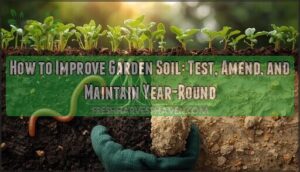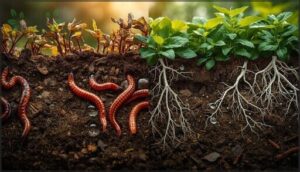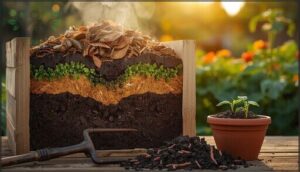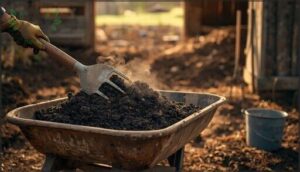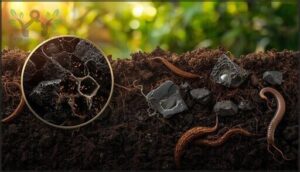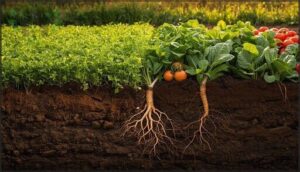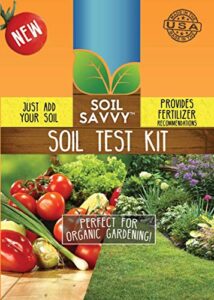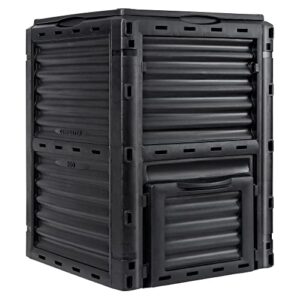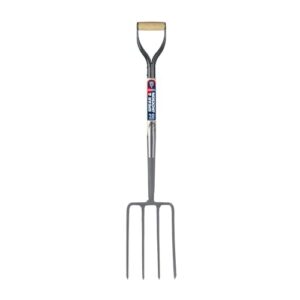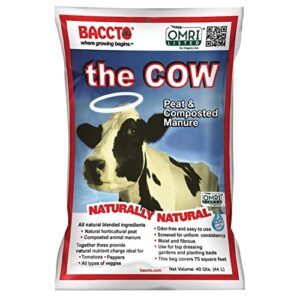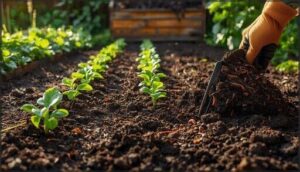This site is supported by our readers. We may earn a commission, at no cost to you, if you purchase through links.
Your garden’s potential sits beneath your feet, locked in soil that may be working against you instead of for you. Most gardeners blame their plants when crops fail or flowers wilt, but the real culprit often lies in poor soil health—depleted nutrients, compacted structure, or pH levels that prevent roots from accessing what they need.
Healthy soil isn’t just dirt; it’s a living ecosystem teeming with microbes, earthworms, and organic matter that work together to feed your plants.
The good news is that you don’t need to replace your soil entirely. With the right testing methods, organic amendments, and maintenance practices, you can transform even the poorest soil into a thriving foundation for abundant growth.
Table Of Contents
- Key Takeaways
- Test and Analyze Your Garden Soil
- Add Organic Matter and Compost
- Implement Cover Crops and Crop Rotation
- Top 6 Products for Improving Soil
- Maintain Healthy Soil Year-Round
- Frequently Asked Questions (FAQs)
- How can i Improve my soil?
- What makes a good garden soil?
- How do you maintain healthy soil?
- How do you take care of soil in your garden?
- How do you improve sandy soil?
- How do you improve soil texture?
- What is the best thing to add to garden soil?
- How do I fix bad soil in my garden?
- What is the fastest way to improve soil quality?
- How do you rejuvenate old soil?
- Conclusion
Key Takeaways
- Test your soil’s pH and nutrient levels first—most garden failures stem from invisible imbalances like iron lockout above pH 7.0 or phosphorus shortages, not from bad gardening skills.
- Add 2-3 inches of compost or aged manure to build a living ecosystem of microbes and earthworms that naturally unlock nutrients, improve water retention by up to 40%, and create the porous structure roots need to thrive.
- Plant cover crops like clover or sorghum-sudangrass between growing seasons to prevent erosion by 99%, add up to 150 kg of nitrogen per hectare, and break pest cycles without synthetic inputs.
- Protect your soil year-round with 3-4 inches of organic mulch, minimal tillage, and drip irrigation—these practices cut water use by 25,000+ gallons annually while preserving the soil structure you’ve worked to build.
Test and Analyze Your Garden Soil
Testing your garden soil is like getting a health check-up before starting a fitness plan. You can’t improve what you don’t understand, and a simple soil test reveals exactly what your garden needs to thrive.
Testing your garden soil is like getting a health check-up before starting a fitness plan
Let’s walk through the essentials of testing and analyzing your soil so you can make informed decisions about amendments.
Understanding Soil PH and Nutrient Levels
Why does soil pH matter so much? It controls nutrient availability, determining what your plants can actually absorb. Most vegetables flourish between pH 5.5 and 7.0, where nitrogen, phosphorus, and potassium become accessible. Understanding pH and NPK ratios helps you:
- Prevent iron chlorosis above pH 7.0
- Avoid manganese toxicity below pH 5.2
- Boost phosphorus solubility at pH 6.0–7.0
- Support calcium and magnesium uptake
- Reduce nutrient deficiencies affecting plant health
To make sure growth is good, it’s important to understand vegetable pH tolerance.
How to Use a Soil Test Kit
Once you understand pH, the next step is using a soil test kit. Mail-in laboratory kits measure nitrogen, phosphorus, potassium, pH, and micronutrients like zinc—far more reliable than rapid tests with color-comparison strips. Kit selection matters: university extensions recommend lab-based testing for precision.
You’ll collect 10 to 20 cores at a sampling depth of 4 to 6 inches, mixing them into composite samples. Air-dry moist soil at room temperature—never use heat. Most labs deliver digital results within two to eight days. To eliminate garden guesswork, use a kit that provides detailed soil analysis.
| Test Type | Best For |
|---|---|
| Mail-in laboratory kit | Precise nutrient values and fertilizer recommendations |
| Colorimetric rapid test | Quick, relative pH and NPK assessments in-garden |
| University extension service | Complete analysis with specific management plans |
| Contaminant screening | Detecting lead, arsenic, or pesticide residues |
| Repeat testing every 2–3 years | Tracking nutrient trends and soil pH changes over time |
Interpreting Soil Test Results
Once your lab report arrives, you’ll see numbers for pH, phosphorus, potassium, calcium, magnesium, and micronutrient levels like zinc and copper. Interpretation is straightforward: each value falls into categories—very low, low, medium, high, or very high—that determine your fertilizer needs.
Low phosphorus means strong crop response to amendments; high levels suggest you can skip extra phosphorus and prevent runoff. Organic matter around 3–5% signals good nutrient retention.
Adjusting PH With Lime and Sulfur
After you’ve read your results, you can adjust soil pH to reach those best ranges of 6.0 to 7.0. Lime application raises pH in acidic soils—sandy loam may need 8 lb per 100 sq ft, clay loam about 15 lb.
Sulfur application lowers high pH, but don’t exceed 20 lb per 1,000 sq ft at once.
Amendment timing matters: lime takes up to eight months; sulfur works faster.
Add Organic Matter and Compost
Adding organic matter to your garden soil is like giving it a nutritious meal that keeps on feeding. Compost, manure, and other amendments improve soil structure, boost beneficial microbes, and help your plants thrive season after season.
Here’s how to choose and apply the right organic materials for your garden’s needs.
Benefits of Compost for Soil Structure
When you add compost to your garden, you’re building a stronger foundation from the ground up. Compost lowers bulk density while boosting aggregate stability, so water retention improves and roots breathe easier.
Enhanced microbial activity creates living networks that bind particles together, and carbon sequestration locks organic matter into place—transforming tired soil into a resilient, thriving ecosystem.
How to Make Your Own Compost
Start your compost pile with a C:N ratio between 25:1 and 35:1—layering brown materials like dried leaves with greens such as kitchen scraps.
Keep moisture around 45–60%, turn the pile when it exceeds 140 °F, and you’ll see active decomposition.
In roughly six months to a year, maturity testing with seed germination confirms your finished compost is ready for the garden.
Using Aged Animal Manure
Beyond compost, aged animal manure from farm animals brings a low-analysis but balanced fertilizer boost—composted cattle manure generally delivers about 1% nitrogen and builds organic matter over time.
Apply 150 pounds per 1,000 square feet, but make sure it’s well-aged for at least 90–120 days to address food safety concerns and reduce environmental risk management issues like pathogen persistence.
Incorporating Biochar for Microbial Diversity
Biochar—charred plant material heated without oxygen—functions as a porous home for soil microbes, raising bacterial diversity by roughly 7% and richness by 10–15% in field studies.
To leverage these microbial community shifts for sustainable gardening, follow three steps:
- Choose mid-temperature biochar (350–550 °C) from herbaceous or wood feedstock types for the strongest long-term effects on soil biodiversity.
- Pre-inoculate biochar with compost tea before spreading to accelerate microbial colonization.
- Mix at 10% by volume into your root zone—about 5–6 cubic feet per 100 square feet—matching proven biochar application rates that boost microbial activity without tying up nutrients.
When and How to Apply Organic Amendments
Amendment timing matters: apply compost in fall to allow months-long decomposition before spring planting, or spread 2–3 inches three weeks before planting for faster nutrient release.
Use 25–100 pounds per 100 square feet, adjusting application rates through soil testing. Make sure microbial conditions favor breakdown—60–80% moisture and warm temperatures speed decomposition.
Incorporate organic matter into the top six inches or top-dress in no-till systems.
Implement Cover Crops and Crop Rotation
Cover crops and crop rotation work hand in hand to keep your soil healthy and productive year after year. These practices protect your garden from nutrient depletion, prevent erosion, and naturally suppress weeds and pests.
Let’s look at how you can use these time-tested techniques to build better soil in your own garden.
Best Cover Crops for Soil Health
You’ll strengthen soil health most effectively by planting cover crops suited to your garden’s needs. Legume benefits include nitrogen-fixing power—field peas and sunn hemp can add over 100 pounds per acre. Grass biomass builders like sorghum-sudangrass deliver high residue for structure.
Crop mixtures offer consistent productivity, while biofumigation brassicas suppress disease.
Overall impacts of cover cropping include enhanced microbial life and carbon gains.
How Cover Crops Prevent Erosion
Once plant roots from your cover crops weave through the topsoil, erosion control becomes remarkably effective. Cover crops reduce soil erosion by up to 99 percent by slowing water runoff and anchoring particles in place.
You’ll also see improved nutrient retention and soil carbon levels. These gains translate to economic benefits—reduced sediment loss means fewer inputs and healthier yields over time.
Planning Effective Crop Rotation
After anchoring your soil with cover crops, you’re ready to map out a rotation that boosts yields by up to 23 percent. Family grouping matters—rotate Solanaceae with Fabaceae, then Brassicaceae and Cucurbitaceae over four years. This strategy balances nutrient needs and disrupts pest lifecycles, cutting disease severity by 20 percent while delivering yield stability season after season.
Here’s your blueprint:
- Year 1: Plant Brassicaceae or Solanaceae.
- Year 2: Rotate to Fabaceae or Apiaceae.
- Year 3: Follow with Solanaceae or Cucurbitaceae.
- Year 4: Complete the cycle with Poaceae or Amaranthaceae.
- Repeat: Start again to sustain long-term soil health.
Using Green Manures to Add Nitrogen
To boost nitrogen fixation, choose legumes like clover or sunn hemp—they can deliver 80 to 150 kg per hectare through biomass production.
Wait at least one week after incorporating green manure before planting to allow proper release timing.
Select species carefully: high-nitrogen cover crops (above 2.5% tissue nitrogen) boost soil fertility and minimize loss pathways, while non-legumes cut nitrate leaching by 70 percent.
Top 6 Products for Improving Soil
You don’t need to spend a fortune to transform your garden soil. The right tools and amendments make the process easier and more effective.
Here are six products that can help you test, build, and maintain healthier soil throughout the year.
1. Soil Savvy Easy Soil Test Kit
You can’t amend what you don’t understand, which is why the Soil Savvy Easy Soil Test Kit gives you clarity on soil nutrients and fertility. This kit measures soil pH plus 14 essential nutrients, then delivers easy-to-read fertilizer recommendations within days.
You’ll receive a professional-grade report that promotes sustainable management by pinpointing exactly what your soil needs. The testing components and report interpretation guide make soil testing and amendments straightforward, helping you build lasting soil fertility without guesswork or waste.
Best For: Home gardeners and lawn care enthusiasts who want professional-grade soil analysis to make informed fertilization decisions and avoid wasting money on unnecessary amendments.
- Tests 14 nutrients plus pH with lab-grade accuracy, giving you a complete picture of what your soil actually needs instead of guessing
- Results include specific fertilizer recommendations tailored to your soil, so you know exactly what to buy and apply
- Promotes sustainable gardening by preventing over-fertilization and helping you use resources efficiently
- Costs more than basic pH-only test kits at $26.95, which some gardeners find steep for a single test
- Requires mailing your soil sample to a lab and waiting 7-10 days for results—no instant answers
- Doesn’t include lime recommendations for adjusting pH levels, so you may need to research that separately
2. F2C Garden Compost Bin Large
The F2C Garden Compost Bin Large holds 80 gallons of kitchen scraps and yard waste, giving you room to build organic matter that feeds soil health year after year. Its BPA-free polypropylene construction offers material durability for outdoor use, while 80 air vents guarantee aeration effectiveness for faster composting.
Bin assembly takes under 90 minutes, and the top-loading design simplifies usability features like adding fresh material. With strong market value for its capacity, this bin turns composting into a practical soil improvement habit.
Best For: Home gardeners with moderate yard waste who want an affordable, large-capacity bin that speeds up composting through passive aeration.
- 80-gallon capacity handles kitchen scraps and yard debris without constant emptying
- 80 air vents promote aerobic breakdown and cut down on anaerobic smells
- BPA-free, UV-resistant polypropylene stands up to sun and rain for seasons of outdoor use
- Some users report flimsy panels and a lid that doesn’t stay firmly in place
- No solid bottom means you need level, well-drained ground for stability and easier compost removal
- Strong winds can tip or shift the bin unless you anchor it down
3. Miracle Gro Dual Chamber Compost Tumbler
The Miracle-Gro Dual Chamber Compost Tumbler speeds up composting performance, turning kitchen scraps and yard waste into finished compost in just 4–6 weeks. Its dual-chamber benefits let you fill one side while the other cures, supporting continuous waste diversion and steady soil amendment production.
Built-in aeration features and internal mixing bars improve oxygen flow, helping beneficial microbes break down organic matter faster. With a total capacity of 105 gallons and straightforward assembly ease, this tumbler delivers practical soil improvement for gardeners ready to boost their soil’s structure and fertility year after year.
Best For: Home gardeners with consistent kitchen and yard waste who want faster composting cycles and the flexibility to keep one batch curing while starting the next.
- Dual chambers let you add fresh material to one side while the other finishes, so you get a steady supply of compost without waiting for full batches to complete.
- Built-in aeration holes and mixing bars speed up decomposition by keeping oxygen flowing through the pile, cutting composting time roughly in half compared to static bins.
- Elevated design and tight-locking doors keep pests out and contain odors better than open heaps, making it practical for smaller yards, patios, or balconies.
- Assembly can be tricky—some panels fit tightly and may require extra effort or patience to line up correctly during setup.
- A few users report leakage of “compost tea” and occasional issues with door latches or locking mechanisms losing stability over time.
- Mixed feedback on long-term durability, with some reviewers noting that plastic components or frame joints may weaken after a season or two of heavy use.
4. Spear Jackson Neverbend Professional Digging Fork
The Spear & Jackson Neverbend Professional Digging Fork addresses heavy-duty soil decompaction with its solid forged carbon steel head and square-profile tines that penetrate compacted clay without bending. Its ergonomic design includes a weatherproofed hardwood handle and long, riveted socket that distribute stress evenly during deep digging.
This material quality aids soil improvement tasks like loosening tough earth before adding amendments, while the epoxy-coated head resists rust and soil adhesion.
Backed by a 10-year warranty, it’s built for gardeners serious about enhancing soil structure and long-term soil health.
Best For: Professional landscapers and serious gardeners working with compacted clay soil, heavy-duty digging projects, or anyone needing a fork that won’t bend or break under tough conditions.
- Forged carbon steel head with square tines penetrates hard clay and compacted soil without bending, even under 130 pounds of leverage
- Extra-long riveted socket and weatherproofed hardwood handle create a reinforced connection that holds up in rocky, difficult terrain where other forks fail
- 10-year warranty and professional-grade construction mean this fork can last decades with proper care, making it a solid long-term investment
- Heavier than fiberglass-handle alternatives, which can make extended digging sessions more tiring
- Wooden handle requires occasional maintenance to keep its weatherproof finish intact
- Higher price point than basic garden forks, though the durability offsets the initial cost over time
5. Baccto Wholly Cow Compost Manure Blend
Baccto Wholly Cow Compost Manure Blend delivers a 40-quart, OMRI-compliant soil amendment that combines composted animal manure and peat for strong nutrient contribution without odor. Adding animal manure this way improves moisture retention and cation exchange capacity, helping sandy or depleted soils hold nutrients longer.
You can spread it at 2-inch depth for roughly 8 to 9 square feet of coverage, then blend it into vegetable beds, flower gardens, or lawn topdressing. Its low environmental impact and stabilized organic matter support beneficial microbes without plant burn—ideal for year-round manure application in diverse contexts.
Best For: Gardeners seeking an odor-free, OMRI-certified soil amendment that combines composted manure and peat to boost nutrients and moisture retention across lawns, vegetable plots, and flower beds.
- OMRI-listed for organic production, with stabilized manure that won’t burn plants and delivers high nutrient content without synthetic fertilizers.
- Improves water-holding capacity by 20–40% in sandy soils and increases cation exchange, helping nutrients stay available to roots longer.
- Versatile application—works as topdressing, backfill amendment, or compost pile activator, with roughly 8–9 square feet of coverage per 40-quart bag at 2-inch depth.
- Higher price point compared to basic compost or manure products, which may add up for larger landscape projects.
- Bags can contain small amounts of sticks or twigs that need picking out before spreading in fine seedbeds.
- No published N–P–K analysis on major retail listings, so precise nutrient planning requires soil testing or trial observation.
6. Fancy Chicken Organic Manure Plant Food
Fancy Chicken Organic Manure Plant Food brings concentrated nutrition from farm animals straight to your beds with its 4-2.5-2 manure NPK ratio and OMRI organic certification. This pelleted chicken fertilizer stimulates soil microbial life while building cation exchange capacity, making it a powerful amendment for vegetables, lawns, and trees.
Application guidelines suggest 150 grams per square meter before planting, incorporated into the top 5 to 10 centimeters.
Handling precautions matter—wear gloves and a dust mask when adding animal manure, because composting and manure processing reduce but don’t eliminate odor during manure application.
Best For: Organic gardeners and farmers who want a slow-release, OMRI-certified fertilizer that builds soil health while feeding vegetables, lawns, and fruit trees.
- High-quality 4-2.5-2 NPK ratio delivers balanced nutrition while stimulating beneficial soil microbes and improving water retention
- Pelleted form makes application easier than raw manure and provides gradual nutrient release throughout the growing season
- USDA-approved organic certification means it’s safe for certified organic production systems
- Strong barnyard smell can be unpleasant, especially when first applied or in enclosed areas
- Dusty pellets require wearing gloves and a dust mask during application to avoid inhaling particles
- Risk of nutrient runoff if over-applied, so following the recommended 150 grams per square meter rate is important
Maintain Healthy Soil Year-Round
Building great soil isn’t a one-time project—it’s an ongoing relationship with your garden. Once you’ve tested and amended your soil, the real work begins: keeping it healthy through every season.
Here are five practical strategies to maintain vibrant, productive soil all year long.
Mulching to Retain Moisture and Regulate Temperature
Think of mulch as a protective blanket for your soil. Organic matter like straw or wood chips reduces water loss by up to 70% compared with bare ground, while keeping soil temperatures 10–15 °C cooler in summer.
Apply 7–10 cm of mulch to garden beds, and you’ll see moisture retention improve dramatically—cutting irrigation needs by about one-third and supporting stronger plant growth.
Preventing Soil Compaction
Compacted soil restricts plant roots and cuts drainage by up to 50%. To prevent this, reduce foot traffic by creating designated pathways—wooden planks or a 15 cm layer of mulch work well. Avoid working wet soil; wait 24–48 hours after rain when it’s friable.
Amend soil structure with compost or deep rooting plants like radishes, which relieve compaction and boost soil aeration naturally.
Reducing Tillage to Preserve Soil Structure
Heavy tilling breaks down aggregates that hold air and water, reducing aggregate stability by up to 49%. No-till gardening preserves soil structure, boosting carbon sequestration and water infiltration while preventing erosion.
Here’s why reducing tillage pays off:
- Healthier soil biota: Earthworms thrive, with populations reaching 137 per square meter versus just 18 under conventional tillage
- Better soil aeration: Macroaggregates maintain pore spaces for roots
- Less soil compaction: Structure stays intact year after year
- Stronger erosion prevention: Stable aggregates resist breakdown during heavy rain
Encouraging Earthworms and Beneficial Organisms
Earthworms and soil microbes are your garden’s unsung heroes. You’ll see worm populations double when soil pH sits between 6.0 and 7.0. Organic mulches boost springtail abundance and support beneficial insects that break down plant residues.
Research shows organic farming systems have 32% to 84% higher microbial biomass than conventional methods. Skip harsh pesticides—they disrupt earthworm behavior and gut microbes that drive nutrient cycling.
Managing Water With Drip Irrigation
Drip irrigation transforms water management by delivering moisture directly to root zones with 90-95% efficiency. You’ll save over 25,000 gallons annually while maintaining consistent soil hydration.
Space emitters 6-12 inches from plant stems and match flow rates to your soil type—sandy soils need 1.0 GPH emitters at 12-inch spacing, while clay performs best with 0.6 GPH at 18 inches.
Regular system maintenance prevents clogging and ensures even water distribution.
Frequently Asked Questions (FAQs)
How can i Improve my soil?
You don’t need expensive fixes—simple soil testing reveals what your garden truly needs.
Add organic matter like compost, use sustainable soil practices, and you’ll see healthier plants through smart soil amendments year-round.
What makes a good garden soil?
Good garden soil has a balanced composition of minerals, organic matter, and pore space. It retains water while draining well, fosters rich microbial life, and maintains a pH around 5 for best nutrient availability.
How do you maintain healthy soil?
Think of healthy soil as a living ecosystem—you’ll protect it with mulch, prevent compaction, minimize tillage, and support nutrient cycling through compost applications.
These practices improve aggregate stability, water infiltration, and the soil food web year-round.
How do you take care of soil in your garden?
Taking care of soil in your garden means regular soil testing, adding organic matter, avoiding compaction, and mulching to maintain water infiltration and mineral availability.
This approach sustains the soil food web and mycorrhizal networks year-round.
How do you improve sandy soil?
Sandy soil amendments like compost, aged manure, and biochar increase organic matter and water retention while reducing nutrient leaching. These additions improve soil texture, promote microbial activity, and prevent erosion, improving soil quality considerably over time.
How do you improve soil texture?
You improve soil texture by adding organic matter like compost or biochar, which increases aggregate stability and pore space.
These amendments impact root penetration, water retention, and aeration, improving overall soil quality and structure.
What is the best thing to add to garden soil?
Compost is the single best addition for improving soil health. It boosts organic matter, enhances soil structure, increases nutrient availability, and bolsters soil microbes—delivering more benefits than manure or biochar at typical amendment timing.
How do I fix bad soil in my garden?
Start by running a soil test to pinpoint nutrient deficiencies, drainage issues, or salinity problems.
Then tackle soil compaction and poor structure with organic matter, addressing specific soil amendments your test reveals for effective soil remediation.
What is the fastest way to improve soil quality?
You can see results in one season by applying high-quality compost at 20–40 tons per hectare, which boosts soil organic carbon by 10–20% and improves nutrient retention rapidly.
How do you rejuvenate old soil?
Rejuvenating old soil starts with adding organic matter like compost or biochar to boost microbial balance. A soil test helps identify nutrient gaps, while amendments like aged manure restore long-term fertility and support soil revitalization.
Conclusion
Yesterday’s soil might’ve felt like a dead end, but today it’s a canvas waiting for transformation. You’ve learned how to improve garden soil through testing, amending with organic matter, and maintaining it season after season.
Each earthworm you encourage, every handful of compost you add, and all the cover crops you plant build a foundation that feeds your garden for years. Your soil isn’t just improving—it’s becoming alive.
- https://www.sciencedirect.com/science/article/pii/S0959652623023065
- https://pmc.ncbi.nlm.nih.gov/articles/PMC10702515/
- https://www.canr.msu.edu/news/compost_increases_the_water_holding_capacity_of_droughty_soils
- https://agrilifetoday.tamu.edu/2023/12/14/soil-health-enhancement-biochar/
- https://catalog.data.gov/dataset/data-from-long-term-compost-use-and-high-frequency-low-concentration-fertigation-reduce-ns

